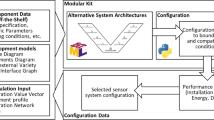Abstract
ViSIAr (Virtual Sensor Integration Architecture) is an idealised framework for building sensing subsystems of flexible assembly and other robotic systems. This paper considers how it supports the design and analysis phase, and might therefore support the exchange of software solutions to sensing problems, by clearly identifying the role and function of software components and de-coupling them from specific hardware. Sensor usage models, specifications of what is to be sensed and the way in which it is sensed, are proposed as the principal objects suitable for design re-use and potentially for code re-use. Generally applicable classes of virtual sensor control models (which form part of sensor usage models) are presented.
Similar content being viewed by others
Explore related subjects
Discover the latest articles, news and stories from top researchers in related subjects.References
Ahmad, A. 1996. A framework for the design of software for robotic sensing, Ph.D. thesis, University of Wales.
Alami, R., Chatila, R., Fleury, S., Ghallab, M., and Ingrand, F. 1998. An architecture for autonomy. International Journal of Robotics Research, 17(4):315–337.
Arkin, R.C. 1998. Behavior-Based Robotics, MIT Press: Cambridge, MA. ISBN 0–262-01165-4.
Arkin, R.C. and MacKenzie, D. 1994. Temporal coordination of perceptual algorithms for mobile robot navigation. IEEE Trans. Robotics and Automation, 10(3):276–286.
Armstrong, E. 1995. Using virtual sensors when doing compliant motion, Technical Report UWA-DCS–95-009, Department of Computer Science, University of Wales, Aberystwyth, UK.
Dekhil, M. and Henderson, T.C. 1998. Instrumented sensor system architecture. International Journal of Robotics Research, 17(4):402–417.
Hardy, N., Barnes, D., and Lee, M. 1987. Declarative sensor knowledge in a robot monitoring system. In NATO ASI Series, 29, Languages for Sensor-Based Control in Robotics, U. Rembold and K. Hörmann (Eds.), Berlin, pp. 169–187.
Hardy, N., Nicholls, H., and Rowland, J. 1992. The design of sensing commands in the InFACT assembly machine. In Proc. 23rd Int. Symp. Industrial Robots (ISIR '92).
Hardy, N., Nicholls, H., and Rowland, J. 1993. Supervision and sensing in flexible assembly. In RoManSy 9. Proceedings of the Ninth CISM-IFToMM Symposium on Theory and Practice of Robots and Manipulators (Udine, Italy), A. Morecki, G. Bianchio, and K. Jaworek (Eds.), London, pp. 385–390.
Hardy, N., Rowland, J., and Nicholls, H. 1995. Supervisory and sensing software for an integrated flexible assembly machine. In Intelligent Assembly Systems, M.H. Lee and J.J. Rowland (Eds.), World Scientific Publishing Co. Pvt. Ltd., pp. 181–207.
Henderson, T. 1985. The specification of logical sensors. In Workshop on Intelligent Control, pp. 95–101.
Henderson, T., Hansen, C., and Bhanu, B. 1985. The specification of distributed sensing and control. J. Robotic Systems, 2(4):387–396.
Henderson, T. and Shilcrat, E. 1984. Logical sensor systems. J. Robotic Systems, 1(2):169–193.
Hooper, J.W. and Chester, R.O. 1991. Software Reuse: Guidelines and Methods, Plenum Press: Software Science and Engineering, New York. ISBN 0 306 43918 2.
Hughes, N. and Wilson, M. 1996. Planned reactions and appropriate responses. In Proc. 4th International Workshop on Advanced Robotics and Intelligent Machines, J. Gray and D. Caldwell (Eds.). ISBN 0 85296 853 1.
InFACT Group 1992. InFACT: Project, Concepts, Machine. MCB University Press Limited: Bradford, UK, 59 pages.
Konolige, K. and Myers, K. 1998. The Saphira architecture for autonomous mobile robots. In Artificial Intelligence and Mobile Robots: Case Studies of Successful Robot Systems, D. Kortenkamp, R.P. Bonasso, and R. Murphy (Eds.), AAAI Press/MIT Press: Menlo Park, CA/Cambridge MA, Chapt. 9, pp. 211–242.
Nicholls, H., Rowland, J., and Sharpe, K. 1989 Virtual devices and intelligent gripper control in robotics. Robotica, 7(3):199–204.
Pressman, R.S. 1997. Software Engineering: A Practitioner's Approach, 5th edition, McGraw-Hill: New York, European adaptation.
Rowland, J. and Nicholls, H. 1989a. A modular approach to sensor integration in robotic assembly. In Proc. INCOM '89: Symposium on Information Control Problems in Manufacturing Technology, Vol. 2 (Madrid), Madrid, pp. 473–479.
Rowland, J. and Nicholls, H. 1989b. A modular approach to sensor integration in robotic assembly. In Information Control Problems in Manufacturing Technology, E. Puente and L. Nemes (Eds.), IFAC, Pergamon Press: Oxford, UK, pp. 371–376.
Rowland, J. and Nicholls, H. 1995. A virtual sensor implementation for a flexible assembly machine. Robotica, 13:195–199.
Sommerville, I. 1995, Software Engineering, 5th edition, Addison-Wesley: Wokinghan, England.
Taylor, R., Summers, P., and Meyer, J. 1982. AML: A manufacturing language. Int. J. Robotics Res., 1(3):19–41.
Tracz, W. 1990. Where does reuse start?. ACM SIGSOFT Software Engineering Notes, 15(2):42–46.
Weller, G., Groen, F., and Hertzberger, L. 1990. A sensor processing model incorporating error detection and recovery. In Traditional and Non-traditional Robotic Sensors, T. Henderson (Ed.), pp. 351–363.
Author information
Authors and Affiliations
Rights and permissions
About this article
Cite this article
Hardy, N., Ahmad, A. De-Coupling for Re-Use in Design and Implementation Using Virtual Sensors. Autonomous Robots 6, 265–280 (1999). https://doi.org/10.1023/A:1008932328457
Issue Date:
DOI: https://doi.org/10.1023/A:1008932328457




